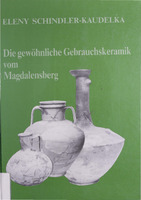Die gewöhnliche Gebrauchskeramik vom Magdalensberg
Author(s)
Schindler Kaudelka, Eleny
Collection
Austrian Science Fund (FWF)Language
GermanAbstract
Excavations on the Magdalensberg in Carinthia, Southern Austria brought to light a huge amount of common wares that have to be divided for study. No parameters to be followed have as yet been fixed and therefore in a first chapter definitions are given on what type of material is used in the book. Red or buff fired liquid containers, mostly wheel turned in Italian workshops out of pretreated clays are dealt with. The chapter chronology approaches the problem form the 40 well defined contexts on different spots of the site, which in 100 years of life offers a division into 7 phases, to be regrouped in 3 periods between 50 BC and 50 AD. A discussion on the possibilities and limits of dating common or utilitarian pottery is included. Typological analysis distinguishes 5 groups, the main one being the Italic shapes and their Hellenistic predecessors. Next come the small transport containers, basically two handled jugs followed by the forms of Celtic inspiration, while a separate chapter combines the single and rare shapes. Some 25 pages are dedicated to the study of results and point out the rare stamps, inscriptions and marks. The plates show drawings and photographs in a typological catalogue as well as a chronological synoptic.
A 2012 paper is intended to integrate the Magdalensberg jugs and pitchers into she state of the art.
SCHINDLER-KAUDELKA, E., Céramiques communes du Magdalensberg. Un cas exceptionnel dans le Norique. – C. BATIGNE VALLET, Les céramiques communes dans leur contexte régional. Faciès de consommation et mode d’approvisionnement (Lyon 2012), 185-218. Die Grabungen auf dem Magdalensberg in Kärnten haben enorme Mengen an Alltagskeramik geliefert, die nicht ohne Unterteilungen vorgelegt werden können. Eindeutige Parameter fehlen bis heute, und so wird im Kapitel Definition die Gruppe eingegrenzt. Untersucht werden helltonige importierte Funde, grob in die Form Krug zu stellen und enger gefasst nach Herkunft, Verwendung und Rohmaterial sowie Fertigungstechniken klassifiziert. Im Anschluss daran wird im Kapitel Chronologie einerseits auf die zur Datierung verwendeten 40 Kontexte im Rahmen der 100 Jahre umfassenden Lebensspanne der Stadt zwischen 50 v. Chr und 50 n. Chr. eingegangen. Drei annähernd gleichlange Perioden werden in 7 Phasen geteilt.und ein theoretischer Ansatz zur Datierung von Gebrauchskeramik diskutiert. Die formenkundliche Auswertung gliedert sich in 5 Gruppen, deren umfangreichste die Italisch geprägten Typen und ihre hellenistischen Vorformen umfasst. Daneben sind kleinere Transportbehälter, meist doppelhenkelig keltisch inspirierte Formen vorhandene. Ein eigenes Kapitel fasst die auf dem Magdalensberg seltenen Formen zusammen. Knapp 25 Seiten sind der Gesamtauswertung gewidmet, in denen auch auf Stempel, Inschriften und Aufschriften eingegangen wird. Im Tafelteil werden die Formen katalogmäßig und chronologisch in Zeichnung und teilweise Foto dargestellt.
In einer Folgearbeit von 2012 wird das Material dem Stand der Forschung gemäß zusammengefasst.
SCHINDLER-KAUDELKA, E., Céramiques communes du Magdalensberg. Un cas exceptionnel dans le Norique. – C. BATIGNE VALLET, Les céramiques communes dans leur contexte régional. Faciès de consommation et mode d’approvisionnement (Lyon 2012), 185-218.
Keywords
Magdalensberg; common wares; Magdalensberg; Gebrauchskeramik; StuckDOI
10.26530/oapen_442083ISBN
3900575053OCN
1030813788Publisher
Verlag des Landesmuseums für KärntenPublication date and place
Klagenfurt, 1989Grantor
Classification
Archaeology


 Download
Download